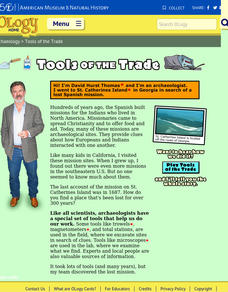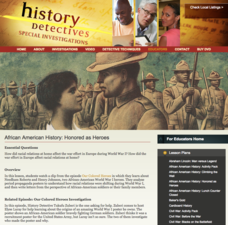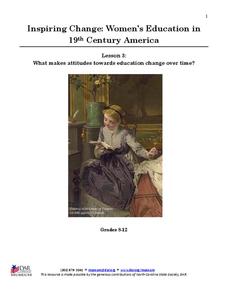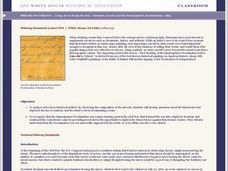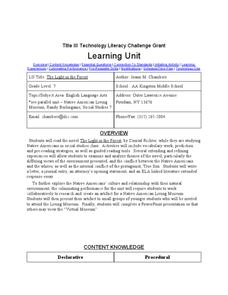American Museum of Natural History
Tools of the Trade
Archaeologist David Hurst Thomas details his search for a lost Spanish Mission on St. Catherines Island, Georgia. A great way to introduce youngsters to the life of and the tools used by archaeologists.
Calisphere
The 6 C's of Primary Source Analysis
Arm your class members with the six C's of primary source analysis—content, citation, context, connections, communication, and conclusions—and help them to establish a solid system for analyzing historical sources of...
Art Institute of Chicago
African Myths and Stories
Young historians discover African stories associated with a royal altar tusk from the Kingdom of Benin in Nigeria, read myths illustrated on the tusk, and write a story about the life of an oba using figures depicted on the tusk.
PBS
African American History: Honored as Heroes
To gain an understanding of the treatment of African American soldiers during World War I, class members watch an excerpt from the History Detectives film, Our Colored Heroes, and then examine three recruitment posters from that...
Smithsonian Institution
War of Independence
Want to explain the War of Independence without using just a textbook? The resource, an online exhibition, provides direct instruction to scholars. It discusses what led up to the war, the time of the war, and the legacy left behind long...
American Museum of Natural History
Being a Zoologist: Sandra Olsen
Are your students wild about horses? Then introduce them Sandra Olsen, a zooarchaeologist, who has been studying horses and the people who herd them. Ms Olsen responds to 15 interview questions and details how she goes about her...
University of California
Interactions in Baghdad and the Abbasid Caliphate
An interesting resource focuses on the cultures of different peoples that have lived in Baghdad and their interactions. Academics view 11 sources to understand how Baghdad has been home to people of many faiths and cultures throughout...
US National Archives
The Royal Seal What Can It Tell Us?
Analyze the images and details of the Great Seal of Queen Elizabeth I, and discover clues that reveal how one of the greatest monarchs in the history of England wished to be seen and respected. This is a great way to discuss how even to...
University of Southern California
Deconstructing Genocide: The Ultimate Crime Against Humanity
There are eight stages of an atrocity known as genocide, and it's important to understand how they are represented so we can fight against it in the future. As young historians watch video clips of ten Jewish Holocaust survivors'...
National Society Daughters of the American Revolution
Lesson 3: What Makes Attitudes Towards Education Change over Time?
The struggle for women's rights is not unique to this generation, or even to the 20th century. Class members explore the conflicting opinions of Alexander Graham Bell and his wife, Mabel Hubbard Bell, regarding women's pursuits of higher...
Newseum
Media Mix-Ups Through History: Analyzing Historical Sources
Scholars use the E.S.C.A.P.E. (Evidence Source, Context, Audience, Purpose, Execution) strategy to analyze a historical source to determine why mistakes happen in news stories. They then apply the same strategies to contemporary flawed...
Curated OER
The Battle of Stones River: The Soldiers' Story
Learners organize items in a "doohickey kit" distributed by the teachers, creating categories using classification schemes. In this classification lesson, students compare systems within groups and write questions that could be answered...
Curated OER
Diggin' The Past
Students explore the culture of Ancient Egypt. In this ancient civilizations lesson, students are divided into groups to research how aspects of culture were influenced by the Nile River. Students create a slide show that describes how...
Curated OER
Mystery of the Maya
Students research the Mayan civilization and complete an artifact dig. In this archeology lesson, students watch an IMAX video about the Mayan civilization. Students discuss archaeology related vocabulary and then work in teams to...
Curated OER
China's Ethnic Minorities
Third graders are introduced to various Chinese ethnic groups. They consider how geography affects ethnic groups and examine artifacts produced by Chinese peoples. They prepare a presentation of their research and artifact interpretation.
Curated OER
Then and Now: Art or Fact
Students complete worksheets about Parliamentary procedure and institutions. They research artifacts, and write a class play based on one artifact.
Curated OER
The Mystery of the Shoe Box
Sixth graders do the work of historians. In this world history lesson, 6th graders examine the artifacts and handouts in mystery boxes that their teachers prepare. Students collaborate to solve the mystery of their assigned boxes as they...
Curated OER
Mysteries of Egypt
Students watch a video about the mysteries of Egypt. They discuss philanthropic acts performed in ancient Egypt. They locate Egypt and landmarks on a map. They finally create a replica of an Egyptian artifact after researching the object.
Curated OER
The Federal Period 1780 - 1820
Within this unit, students evaluate the prosperity of a New England town during the Federal Period. Throughout the unit, students are looking for evidence of prosperity by examining artifacts such as inventories, tax lists, and photos to...
Curated OER
Using Art to Study the Past: Abraham Lincoln and the Emancipation Proclamation - 1863
Fifth graders analyze artwork as historical artifact and recognize that the Emancipation Proclamation was a major turning point in the Civil War.
Curated OER
Coining Scientific Discoveries
Middle schoolers explain the objectives of the Lewis and Clark Expedition and the relationship of those objectives to the designs od the Westward Journey Nickel Series They conduct research on artifacts Lewis and Clark examined on the...
Curated OER
Native American Culture: The Light in the Forest
Seventh graders read the novel, The Light in the Forest. They work in groups to research and create artifacts for a Native American Living Museum. They complete a Powerpoint presentation of their virtual museum to classmates.
Curated OER
Beauty
Students bring an object to school that is of significant sentimental value to them. They arrange the objects in a class display, examine each other's artifacts and discuss the implications and cultural bias of the word 'beauty'.
Curated OER
View: Visual Inquiry/Experience in Writing
Learners discuss the importance of having good observational skills. Using artifacts, they discuss what can and cannot be told about previous cultures. They use their observations to write a paper about the culture and use the internet...
Other popular searches
- Inca Artifacts
- Cultural Artifacts
- Archeology Artifacts
- Indian Artifacts
- Artifacts and Archeology
- Native American Artifacts
- Historical Artifacts
- Ancient Cultures Artifacts
- American Artifacts
- Artifact Protection
- Artifact Classification
- Ancient Chinese Artifacts
